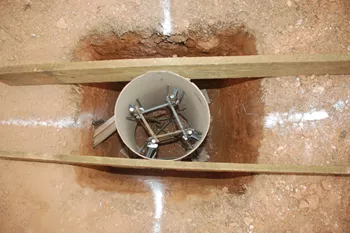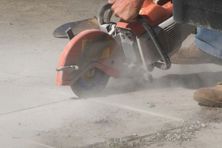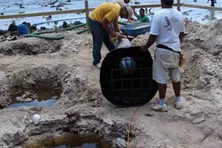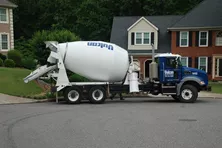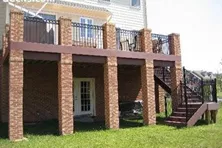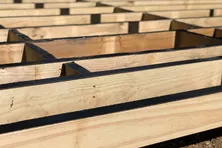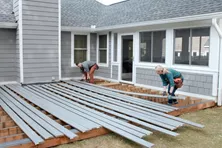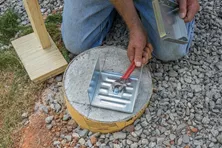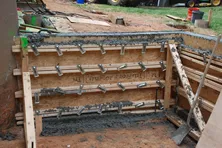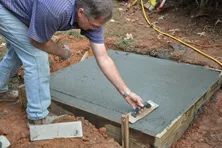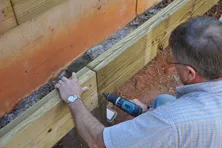Protecting Your Holes from Collapse
Once your holes are in place, how do you make sure they don’t cave in and waste all of your hard work? One easy solution is to purchase cardboard form tubes and place them in the holes to prevent the holes from collapsing. These tubes are sold in different sizes. You will probably want 12” or 16” diameter tubes that are at least 6’ tall. For about $20 each, you can save yourself the frustration of redigging collapsed holes. You can remove the tubes after the footing inspection or leave them in the ground to naturally degrade in the soil.
You will also want to cover the holes with something to keep water out. If your holes fill with water, they are more likely to collapse and you will not be able to pass a footing inspection while water is in the bottom of the hole. You can use plywood or tarps, some people have even used garbage can lids. Try to coordinate your footing inspection so that you don’t have to leave the footings open for a long period of time.
Cutting a Concrete Pad
Learn how to use a concrete saw to cut a hole in a patio slab to install a deck footing.
Water in deck footing holes
Find out what to do if your deck footing holes fill up with water.
How to Buy Concrete: Hiring a Ready-Mix Truck
Hiring a truck to deliver ready-mixed concrete for your project may make better sense than mixing it yourself. Learn how to order concrete for your deck at Decks.com.
How to Decorate Deck Support Columns
Browse some examples of decorative deck support posts for tall decks.
Why is Joist Protection so Important for Your Deck?
If you’ve ever seen a piece of wood left out in the weather for any period of time, you know what happens: decay. Whether through wet rot, insect damage, or mildew, the fibers begin to break down.
How to Slope a Deck for Water Runoff and Drainage
Learn if your deck needs to be sloped and how to do it.
More Helpful Resources
Explore Articles by Topic

Footings
Information related to installing frost footings for decks

Framing
Learn structural framing methods

Decking
Learn about wood and composite decking materials

Stairs
An in-depth look at the complex issue of how to build stairs

Railings
How to install guardrails and handrails to meet IRC code

Features
An overview on water drainage, benches, planters and lights

Design
The basics of deck design

Planning
Learn about permits and working with contractors

Porches & Patios
Build a covered deck to enjoy all seasons

Ledger
Proper attachment techniques

Care
Maintain your deck to maintain your investment

Materials
An overview on water drainage, benches, planters and lights
How many footings do I need?
Learn how to determine the number of footings and support posts you need for your deck when designing your deck frame.
Retaining Walls
Avoid problems related to digging deck footings near retaining walls. Learn some tips from the pros for how to handle these difficult situations.
Working With Concrete
Learn tips from the pros on how to mix and pour concrete for deck footings.
Why is Joist Protection so Important for Your Deck?
If you’ve ever seen a piece of wood left out in the weather for any period of time, you know what happens: decay. Whether through wet rot, insect damage, or mildew, the fibers begin to break down.
Beam Span Chart
Learn how to size your deck beam using this easy-to-use span table. Just cross-reference the post spacing and joist length to determine the beam size.
How to Slope a Deck for Water Runoff and Drainage
Learn if your deck needs to be sloped and how to do it.
Explore Articles by Topic

Footings
Information related to installing frost footings for decks

Framing
Learn structural framing methods

Decking
Learn about wood and composite decking materials

Stairs
An in-depth look at the complex issue of how to build stairs

Railings
How to install guardrails and handrails to meet IRC code

Features
An overview on water drainage, benches, planters and lights

Design
The basics of deck design

Planning
Learn about permits and working with contractors

Porches & Patios
Build a covered deck to enjoy all seasons

Ledger
Proper attachment techniques

Care
Maintain your deck to maintain your investment

Materials
An overview on water drainage, benches, planters and lights




